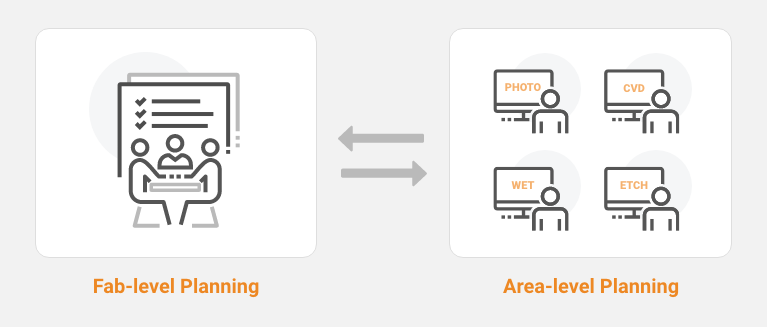Capacity Planning in Semiconductor Fab: Practice and Challenges
May 01, 2022
As the global semiconductor shortage continues, major semiconductor companies are rushing to build new wafer fabrication facilities (fab) in the US. TSMC announced they will build a new fab in Arizona; Samsung, Texas Instruments, and Micron will build fabs in Texas; Intel in Arizona and Ohio, and Global Foundries expands into a new fab in New York. Especially in this capital expenditure (CAPEX) industry, it is very important to verify that target production can be achieved with planned resource investment. As a result, there is an increasing need for a next-generation capacity planning system that provides an optimal solution while enabling more accurate and faster calculations.
Capacity planning (CP) optimizes the resource allocation to establish a plan and fulfill the (forecast) demand. Semiconductor fab manufacturing has some special features that complicate the analysis of such systems: 1) large number of processing steps; 2) re-entrant flows; 3) batch tools; and 4) random failures. The main consequence of the re-entrant flow nature is that wafers at different layers in their manufacturing cycle must compete with each other for the same machines.
CP Practice & Classification
In practice, capacity planning is performed by a series of cyclic activities as shown in Figure 1 Each area planner evaluates alternatives and makes an initial plan for the area. The area-level plan is based on estimated lot arrivals and the required target for the area. Since the incoming lot arrival profile is decided by other area plans, area planners get together and create a fab-level plan. According to the agreed fab-level plan, each area planner adjusts his/her area plan again.

Figure 1: Capacity planning cycle
CP has two major usages as the following:
• Quarter plan (Q-Plan in short): It supports the master plan (MP) which decides the weekly production volume of each finished product typically for 13 weeks. It finds the plan to improve the original promised date (OPD) for the given MP.
• Year plan (Y-Plan): It assesses whether the resource capacity is sufficient for the demand projection for the next couple of years with a longer than 12-month plan-horizon. It is also used for new fab construction planning. It focuses on validating the product mix and tool investment.
Quarter Plan (Q-Plan), Year Plan (Y-Plan)
Area-level Q-planning finds bottleneck tools in the area and establishes a plan to meet step targets by increasing loadable tools or adjusting the preventive maintenance (PM) schedule to improve tool utilization. Daily workload chart helps find bottlenecks. By multiplying the number of wafers processed in one day by the tact time, it is possible to calculate the time the equipment is operating, that is, the RUN workload whose maximum value is 24 hours. Similarly, the WAIT workload is calculated from the number of waiting wafers at the end of the day.
In order to meet long-term demand projection, Area-level Y-Planning finds equipment with insufficient capacity in the area, adjusts loadable tool arranges and determines an additional number of equipment to be purchased if necessary.
Capacity planning poses some challenges regardless of the strategy or methodology as follows:
• Inaccurate and incomplete master data
• Difficult to create new input data
• Unbalanced Eqp-Arrange among machines
• Inaccurate decision based on static WIP inflow
• Difficult to compare alternatives
Having the right solution is critical as capacity plans are being developed It should support not only to validate return on investment but also to be able to anticipate market demands and to effectively allocate resources.
Conclusion
Capacity planning verifies not only the feasibility of investment based on long-term plans such as a new plant construction but also the feasibility of quarterly production plans. There is a continuous need for a cutting-edge solution that can establish long-term/short-term plans and area-level/fab-level plans with one simulation model. The system enables to conduct various “what-if simulations” and compares the results through an intuitive KPI report and view.
Learn more: Resource Download



